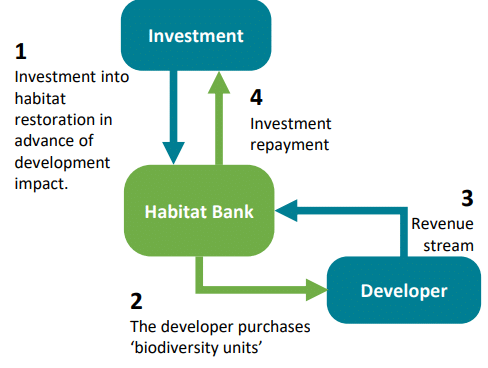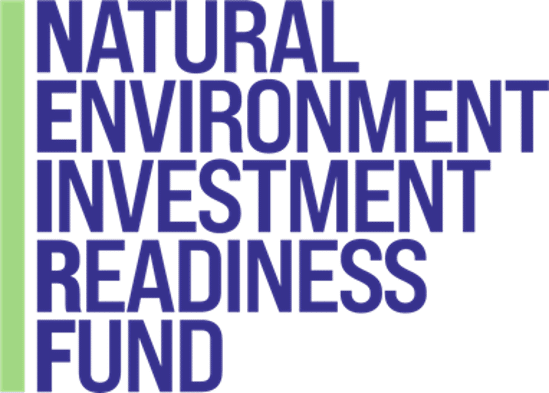Project Overview
A group of Wildlife Trusts and Finance Earth have created an investment model to deliver Biodiversity Net Gain (BNG) units with the use of upfront private finance, accelerating the delivery of high-quality local habitat banks. The partnership includes four Wildlife Trusts – Berks Bucks and Oxon, Warwickshire, Cheshire and Surrey – that will create and restore habitats across their counties. By using private investment to create the habitats in advance of BNG sales, the Wildlife Trusts will have a higher volume of ‘post-enhancement’ units that will support the financial viability of the project over the long-term and remove the time delay between nature loss from development and off-site habitat creation.
Acknowledgements
With many thanks for their time and insight on this case study:
Prue Addison, Conservation Strategy Director, Berkshire, Buckinghamshire and Oxfordshire Wildlife Trust
Alicia Gibson, Senior Associate Director, Finance Earth
Allan Benhamou, Associate, Finance Earth
Date published: 23/06/2023
Project mandate
The Wildlife Trusts (WTs) have a commitment to seeing 30% of land and sea well managed for nature by 2030, in line with ambitions of the UK government and the post-2020 Global Biodiversity Framework. However, their current funding model is reliant on traditional forms of public and third sector grant funding, which is insufficient to meet this ambitious ‘30 by 30’ target.
This project is run by a group of WTs and aims to meet this target by exploring the use of private finance, alongside other funding sources, to deliver biodiversity net gain (BNG).
It focuses on the work of three WTs: Berks, Bucks and Oxon Wildlife Trust (BBOWT), Cheshire Wildlife Trust (CWT) and Warwickshire Wildlife Trust (WWT). Surrey Wildlife Trust (SWT) were involved in a separate project with a focus on the development of a Natural Capital Investment Company but worked closely with this project to share knowledge around the development of BNG investment models.
Since July 2021, these four WTs and Finance Earth have been working to develop a scalable habitat banking model and create a positive impact for nature. Given the market opportunity for BNG units (see below), the WTs considered that they would be well-placed to support the delivery of high-quality habitat banks, due to their local partnerships and knowledge, credibility, capacity and experience enhancing landscapes for nature and communities. They also partnered with Finance Earth to explore financial structures and investment models.
Overall, the project has:
- Developed a new WT habitat banking investment model that enables the delivery of BNG at scale.
- Obtained indicative commitments from buyers/investors to enable WTs to deliver habitat banking pilots.
New market opportunity
The project’s revenue streams are based on the nascent BNG market for biodiversity units. From November 2023, BNG will become a legal requirement for nearly all property development in England – developers must deliver a 10% net gain in biodiversity by installing ecological interventions on site. If BNG cannot be achieved within the development site, developers must purchase offsite biodiversity units, calculated by Defra’s . Habitats that deliver these units must be maintained for a minimum 30 years. This is an example of a ‘compliance market’.
The WTs saw an opportunity to deliver significant biodiversity benefits and generate a supply of BNG units to meet development demand. The BNG market is expected to generate £200 million in revenues for offsite habitat creation per year in England (eftec BNG market analysis, 2021). Development pressure across the regions covered by the WTs creates an annual demand for 25,000 new homes, according to initial research undertaken by the project team of Local Plans.
The project team also saw that ‘patient investment’ could play a vital role in the project and the broader BNG market, due to how the Biodiversity Metric calculates units from habitats that are already established. The Biodiversity Metric applies specific ‘difficulty’ multipliers before a habitat has reached a target condition (‘pre-enhancement’) that reduces the overall number of units that can be sold. The Biodiversity Metric reduces these multipliers once a habitat has reached its target condition, thereby increasing the overall number of units generated when habitat conditions are met before units are sold.
As a result, and if project developers can meet up-front creation costs, they can receive up to twice as many BNG units from a site if these are sold post-enhancement, compared to an upfront sale. The project team therefore saw the potential for upfront investment to improve the financial viability of the project, and also minimise the time delay between nature loss from development and off-site habitat creation.
At the time of project development, the policy environment surrounding BNG was still being developed, with secondary legislation expected to be passed in 2023. As such, there were several uncertainties on how BNG policy would affect key aspects of the project, such as habitat banking registration, monitoring requirements, application of the Biodiversity Metric itself and any ability to ‘stack’ revenues from different ecosystem services. To help mitigate this, the project team had ongoing engagement with key BNG policy leads through the Natural Environment Investment Readiness Fund (see below) to provide feedback on policy challenges, address key uncertainties and understand the latest on policy developments as the project progressed.
Site identification and assessment
The project team decided to work with sites under different ownership arrangements to explore how the approach would work under a range of circumstances, including land under ownership, land acquisition and a land leasing structure. Sites were identified through considering a range of factors, including:
- Alignment to WT organisational objectives and ecological priorities.
- Strategic location within a local nature recovery strategy priority area.
- Near to established nature reserves to enable connectivity.
- Suitable scale to deliver ecological benefits and cost efficiencies.
- Biodiversity unit uplift potential based on a low initial baseline.
- Local development demand.
Once these sites were identified, the project teams undertook a ‘site ecological baseline’ on each pilot site. The teams then explored different 30-year management approaches and ecological outcomes, and reached a preferred biodiversity uplift scenario that was run through the Defra metric to calculate the number of units that each site would generate. The uplift scenarios chosen were based on WT experience of land management for conservation outcomes that reflect the Lawton principles of creating bigger, better, and more joined up landscapes.
After determining the site baseline and target habitats, the project team then used the Biodiversity Metric to calculate the number of BNG units that could be generated.
It was also important at this stage to assess the potential local demand for BNG units, as their use to developers are restricted by the habitat’s geographic proximity to the development.
From this process, the project team identified three pilot sites to develop the investment model, covering an area of 128 hectares across the areas of three WTs. These are able to deliver between 540 and 1,130 BNG units, depending on the biodiversity unit selling strategy. The pilot sites are:
- Oxfordshire pilot site – a 45-hectare rewilding site located in the BBOWT area, next to an adjoining nature reserve. Planned interventions focus on habitat enhancement rather than habitat creation, such as the rewilding of wetland mosaic, scrub and woodland restoration.
- Warwickshire pilot site – a 62-hectare site in the Warwickshire WT area that sits next to a Site of Special Scientific Interest (SSSI). The site will be converted with the creation of grassland, heathland, wetland and woodland.
- Cheshire pilot site – a 45-hectare site in the Cheshire WT area. It is former agricultural land that will be enhanced with grassland, woodland and wetland creation.
Assuming a fixed price of £20,000 per unit over time (eftec (2021) BNG market analysis) and based on the sale of 540-1,130 units, these pilot sites could generate between £11m-22m of undiscounted BNG revenues over 30 years.
Next Steps
Following on from the site identification and assessment, the project team then financially appraised the sites, further developing the financial model and business case of the project as a whole. This involved:
- a more detailed assessment of the BNG unit generation,
- assessment of project viability by comparing costs and revenues
- refinement of local demand assessment, sale profile and preferred sale strategy
- Identifying the need for third party investment and financing options
Development Funding
The project received a £100,000 grant from the first round of the Natural Environment Investment Readiness Fund (NEIRF), a project development fund that was set up by Defra and is administered by the Environment Agency. Applications were submitted by February 2021 and funding was announced in July 2021. BBOWT led the preparation of the grant application, in collaboration with the partner WTs and Finance Earth.
The funding was used to commission Finance Earth as the financial advisor, commission Bidwell’s to provide BNG delivery guidance considerations, and cover a small proportion of WT internal time committed to the project. All project partners contributed substantial additional in-kind resources to the project beyond allocated funds.



